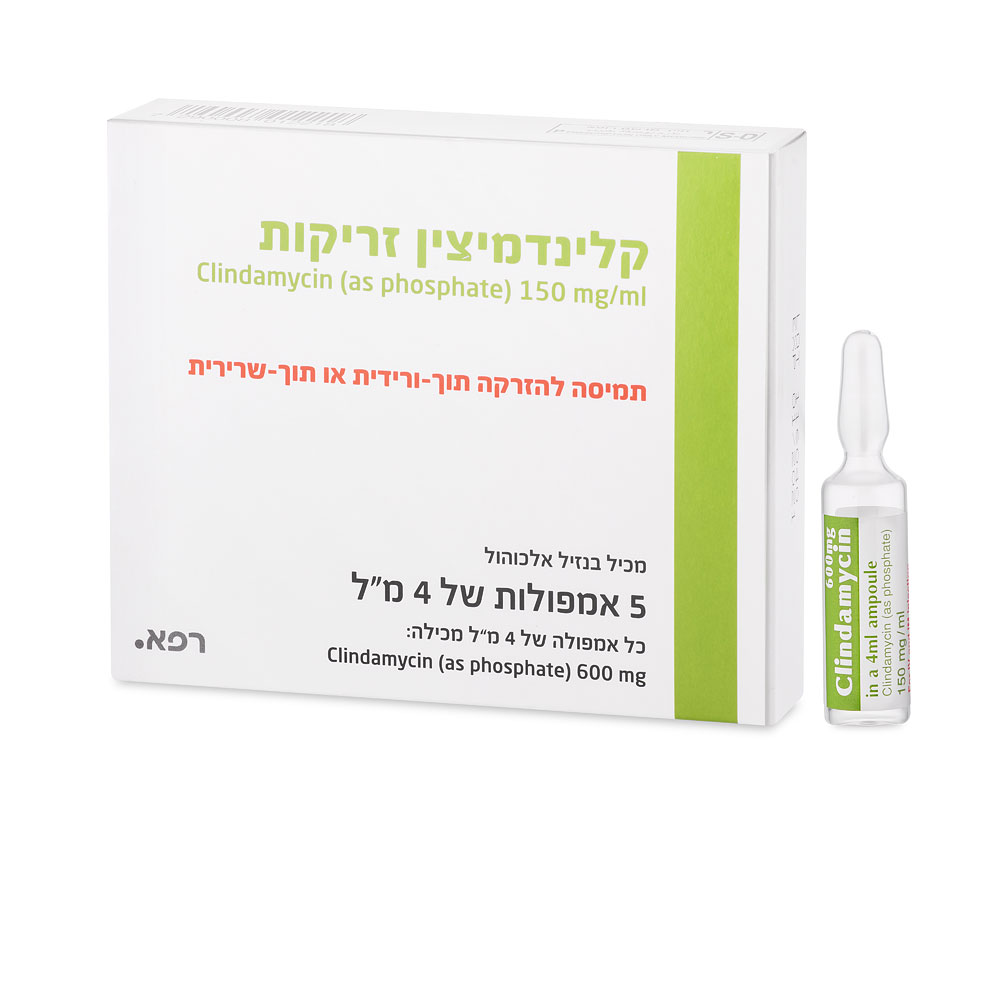Quest for the right Drug

קלינדמיצין זריקות CLINDAMYCIN INJECTIONS (CLINDAMYCIN AS PHOSPHATE)
תרופה במרשם
תרופה בסל
נרקוטיקה
ציטוטוקסיקה
צורת מתן:
תוך-שרירי, תוך-ורידי : I.M, I.V
צורת מינון:
תמיסה להזרקה : SOLUTION FOR INJECTION
עלון לרופא
מינוניםPosology התוויות
Indications תופעות לוואי
Adverse reactions התוויות נגד
Contraindications אינטראקציות
Interactions מינון יתר
Overdose הריון/הנקה
Pregnancy & Lactation אוכלוסיות מיוחדות
Special populations תכונות פרמקולוגיות
Pharmacological properties מידע רוקחי
Pharmaceutical particulars אזהרת שימוש
Special Warning עלון לרופא
Physicians Leaflet
Pharmacological properties : תכונות פרמקולוגיות
Pharmacodynamic Properties
5.1 Pharmacodynamic properties Pharmacotherapeutic group: Lincosamide antibiotics, ATC Code J01FF01 Mode of action Clindamycin is a lincosamide antibiotic with a primarily bacteriostatic action against gram-positive aerobes and a wide range of anaerobic bacteria. Lincosamides such as clindamycin bind to the 50S subunit of the bacterial ribosome similarly to macrolides such as erythromycin and inhibit protein synthesis. The action of clindamycin is predominantly bacteriostatic although high concentrations may be slowly bactericidal against sensitive strains. Although clindamycin phosphate is inactive in vitro, rapid in vivo hydrolysis converts this compound to the antibacterially active clindamycin. Resistance Resistance to clindamycin usually occurs via macrolide-lincosamide-streptogramin B (MLSB) type of resistance, which may be constitutive or inducible. Breakpoints The minimum inhibitory concentrations (MIC) breakpoints are as follows: EUCAST Staphylococci: sensitive ≤ 0.25 resistant > 0.5 Streptococci ABCG and pneumoniae: sensitive ≤ 0.5 resistant > 0.5 gram-positive anaerobes: sensitive ≤ 4 resistant > 4 gram-negative anaerobes: ≤ 4 resistant > 4 PK/PD relationship Efficacy is related to the ratio of the area of the concentration-time curve of unbound antibiotic to the MIC for the pathogen (fAUC/MIC). Susceptibility The prevalence of acquired resistance may vary geographically and with time for selected species and local information on resistance is desirable, particularly when treating severe infections. As necessary, expert advice should be sought when local prevalence of resistance is such that the utility of the agent in at least some types of infections is questionable. Species Susceptible Gram-positive aerobes Staphylococcus aureus* Staphylococcus epidermidis Streptococcus pneumonia Streptococcus pyogenes Viridans streptococci Anaerobes Bacteriodes fragilis group Prevotella formerly known as Bacteroides melaninogenicus Bifidobacterium spp. Clostridium perfringens Eubacterium spp. Fusobacterium spp. Peptococcus spp. Peptostreptococcus spp. Propionibacterium spp. Veillonella spp. Resistant Clostridia spp. Enterococci Enterobacteriaceae *Up to 50% of methicillin-susceptible S. aureus have been reported to be resistant to clindamycin in some areas. More than 90% of methicillin-resistant S.aureus (MRSA) are resistant to clindamycin and it should not be used while awaiting susceptibility test results if there is any suspicion of MRSA. Most gram-negative aerobic bacteria, including the Enterobacteriaceae, are resistant to clindamycin. Clindamycin demonstrates cross-resistance with lincomycin. When tested by in vitro methods, some staphylococcal strains originally resistant to erythromycin rapidly developed resistance to clindamycin. The mechanisms for resistance are the same as for erythromycin, namely methylation of the ribosomal binding site, chromosomal mutation of the ribosomal protein and in a few staphylococcal isolates enzymic inactivation by a plasmid-mediated adenyltransferase.
Pharmacokinetic Properties
5.2 Pharmacokinetic properties General characteristics of active substance Following parenteral administration, the biologically inactive clindamycin phosphate is hydrolysed to clindamycin. When the equivalent of 300 mg of clindamycin is injected intramuscularly, a mean peak plasma concentration of 6 microgram/ml is achieved within three hours; 600 mg gives a peak concentration of 9 microgram/ml. In children, peak concentration may be reached within one hour. When the same doses are infused intravenously, peak concentrations of 7 and 10 micrograms per ml respectively are achieved by the end of infusion. Clindamycin is widely distributed in body fluids and tissues including bone, but it does not reach the cerebrospinal fluid in significant concentrations. It diffuses across the placenta into the fetal circulation and appears in breast milk. High concentrations occur in bile. It accumulates in leucocytes and macrophages. Over 90% of clindamycin in the circulation is bound to plasma proteins. In vitro studies in human liver and intestinal microsomes indicated that clindamycin is predominantly oxidized by CYP3A4, with minor contribution from CYP3A5, to form clindamycin sulfoxide and a minor metabolite, N desmethylclindamycin. The half-life is 2 to 3 hours, although this may be prolonged in pre-term neonates and patients with severe renal impairment. Clindamycin undergoes metabolism, to the active N-demethyl and sulfoxide metabolites and also some inactive metabolites. About 10% of the drug is excreted in the urine as active drug or metabolites and about 4% in the faeces; the remainder is excreted as inactive metabolites. Excretion is slow and takes place over several days. It is not effectively removed from the blood by dialysis. Characteristics in patients No special characteristics. See section 4.4 for further information. Obese paediatric patients aged 2 to less than 18 years and obese adults aged 18 to 20 years An analysis of pharmacokinetic data in obese paediatric patients aged 2 to less than 18 years and obese adults aged 18 to 20 years demonstrated that clindamycin clearance and volume of distribution normalized by total body weight are comparable regardless of obesity.

שימוש לפי פנקס קופ''ח כללית 1994
התרופה תימצא רק בבתי חולים ותנופק לחולים אמבולטורים רק באמצעותם
תאריך הכללה מקורי בסל
01/01/1995
הגבלות
תרופה אשפוזית לפי החלטת משרד הבריאות
מידע נוסף
